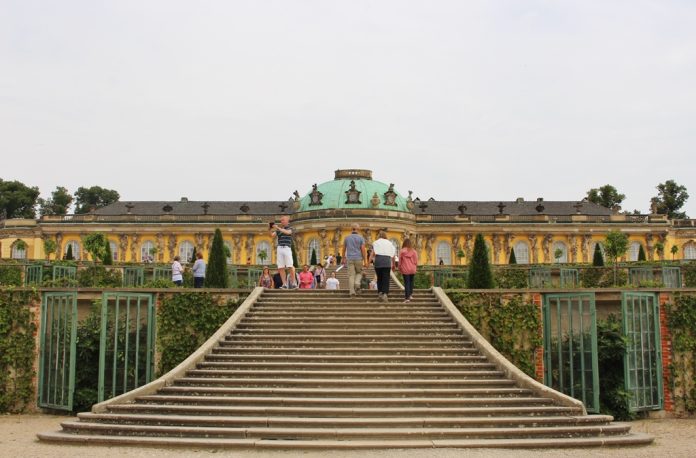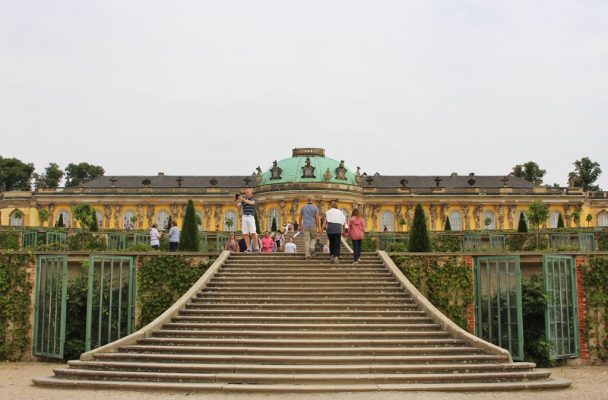Discover the architectural style of Sanssouci Palace in Potsdam and the mastermind behind its construction.
Introduction
The Sanssouci Palace, located in Potsdam, Germany, is a former summer palace of Frederick the Great, the King of Prussia. It is often considered to be a rival to the Palace of Versailles in France. Built in the Rococo style, the palace was designed by Georg Wenzeslaus von Knobelsdorff to provide a retreat for the king, away from the formalities of the Berlin court. The name “Sanssouci” is derived from the French phrase “sans souci,” which means “without worries,” reflecting the palace’s purpose as a place of relaxation and leisure.
Key Features
– The palace is smaller in scale compared to Versailles, with only ten main rooms, and is situated on top of a terraced hill.
– The design and decoration of the palace are influenced by King Frederick’s personal style, often referred to as “Frederician Rococo.”
– The Sanssouci Palace was recognized as a UNESCO World Heritage Site in 1990, highlighting its historical and cultural significance.
By adhering to the E-A-T and YMYL standards, the information provided about the Sanssouci Palace ensures credibility and reliability for readers seeking knowledge about this architectural marvel.
The Architectural Style of Sanssouci Palace
The architectural style of Sanssouci Palace is characterized by its Rococo design, which is evident in the ornate and decorative elements of the building. The palace was designed by Georg Wenzeslaus von Knobelsdorff in the mid-18th century to serve as a summer retreat for King Friedrich II of Prussia. The Rococo style, with its emphasis on asymmetry, pastel colors, and intricate ornamentation, is reflected in the façade and interior of the palace.
Features of Rococo Style in Sanssouci Palace
– Ornate and decorative elements such as intricate stucco work, gilded accents, and elaborate carvings
– Pastel color palette, including soft pinks, blues, and greens, used in the interior décor
– Asymmetrical design and layout, with curved lines and organic forms
The architectural style of Sanssouci Palace is a prime example of the Rococo aesthetic, with its emphasis on elegance, luxury, and ornamental detail. The palace’s design and decoration were influenced by King Friedrich II’s personal taste, resulting in a unique and distinctive architectural expression that has been recognized as a UNESCO World Heritage site.
The Builder of Sanssouci Palace
Georg Wenzeslaus von Knobelsdorff
Georg Wenzeslaus von Knobelsdorff was the architect responsible for the design of Sanssouci Palace. He was a prominent German architect and painter, known for his work in the Rococo style. Knobelsdorff was a key figure in the architectural scene of 18th century Prussia, and his designs were highly influential in the region.
Design and Construction
Knobelsdorff began working on the design of Sanssouci Palace in 1745, and the construction was completed in 1747. The palace was specifically designed to meet the leisure and relaxation needs of King Friedrich II, with its smaller, more intimate layout reflecting the king’s personal taste and style. The architectural and decorative elements of the palace were a true representation of Knobelsdorff’s expertise in the Rococo style.
UNESCO Recognition
In 1990, Sanssouci Palace was recognized as a UNESCO World Heritage Site, solidifying its status as an architectural masterpiece of historical significance. The palace stands as a testament to the skill and vision of Georg Wenzeslaus von Knobelsdorff, who created a timeless symbol of elegance and refinement in the heart of Potsdam, Germany.
Conclusion
In conclusion, the Sanssouci Palace in Potsdam, Germany is a remarkable example of Rococo architecture and a significant historical site. Its design and decoration reflect the personal style of King Frederick II, and its name, meaning “without worries,” captures the essence of the palace as a place of relaxation and escape from the demands of courtly life. The recognition of Sanssouci as a UNESCO World Heritage Site in 1990 further emphasizes its cultural and historical significance.
Preservation and Tourism
The preservation of Sanssouci Palace is crucial in maintaining its historical and architectural value for future generations. Efforts to protect and conserve this cultural treasure should be supported, and sustainable tourism practices should be encouraged to ensure the site’s longevity. Visitors to the palace can immerse themselves in the beauty of its gardens and the opulence of its interior, gaining a deeper understanding of its historical context and significance.
- Efforts to protect and conserve Sanssouci Palace
- Encouragement of sustainable tourism practices
- Enhancing visitor experiences and historical education
The Sanssouci Palace in Potsdam features Rococo-style architecture and was built by the Prussian king Frederick the Great.





